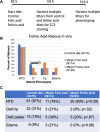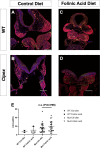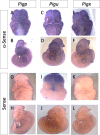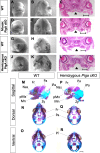Glycosylphosphatidylinositol biosynthesis and remodeling are required for neural tube closure, heart development, and cranial neural crest cell survival
- PMID: 31232685
- PMCID: PMC6611694
- DOI: 10.7554/eLife.45248
Glycosylphosphatidylinositol biosynthesis and remodeling are required for neural tube closure, heart development, and cranial neural crest cell survival
Abstract
Glycosylphosphatidylinositol (GPI) anchors attach nearly 150 proteins to the cell membrane. Patients with pathogenic variants in GPI biosynthesis genes develop diverse phenotypes including seizures, dysmorphic facial features and cleft palate through an unknown mechanism. We identified a novel mouse mutant (cleft lip/palate, edema and exencephaly; Clpex) with a hypo-morphic mutation in Post-Glycophosphatidylinositol Attachment to Proteins-2 (Pgap2), a component of the GPI biosynthesis pathway. The Clpex mutation decreases surface GPI expression. Surprisingly, Pgap2 showed tissue-specific expression with enrichment in the brain and face. We found the Clpex phenotype is due to apoptosis of neural crest cells (NCCs) and the cranial neuroepithelium. We showed folinic acid supplementation in utero can partially rescue the cleft lip phenotype. Finally, we generated a novel mouse model of NCC-specific total GPI deficiency. These mutants developed median cleft lip and palate demonstrating a previously undocumented cell autonomous role for GPI biosynthesis in NCC development.
Keywords: Folic/folinic acid; congenital disorders of glycosylation; craniofacial; development; developmental biology; glycosylphosphatidylinositol; mouse; neural crest.
© 2019, Lukacs et al.
Conflict of interest statement
ML, TR, PC, RS No competing interests declared
Figures
















References
-
- Bassuk AG, Muthuswamy LB, Boland R, Smith TL, Hulstrand AM, Northrup H, Hakeman M, Dierdorff JM, Yung CK, Long A, Brouillette RB, Au KS, Gurnett C, Houston DW, Cornell RA, Manak JR. Copy number variation analysis implicates the cell polarity gene glypican 5 as a human spina bifida candidate gene. Human Molecular Genetics. 2013;22:1097–1111. doi: 10.1093/hmg/dds515. - DOI - PMC - PubMed
-
- Behringer R. Manipulating the Mouse Embryo: A Laboratory Manual. Fourth edition. New York: Cold Spring Harbor Laboratory Press; 2014.
Publication types
MeSH terms
Substances
Associated data
- Actions
- Actions
Grants and funding
LinkOut - more resources
Full Text Sources
Molecular Biology Databases

